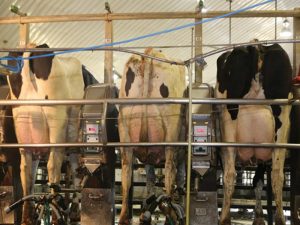Weather watcher Clive Akers has tracked many farms lasting without rain for 40 days around his sheep and beef farm near Palmerston North.
He said moist clouds and a couple of rain spots had shown promise, but the rain gauge had not had a drop since November 7.
Since rain records began on his farm in 1948 the longest period without rain had been 27 days during January and February of 1963.
 Akers said the region received a record low of 12.6 millimetres of rain last month. The previous record low for November was 19.3mm in 1972 and the average for the month was 72mm.
Akers said the region received a record low of 12.6 millimetres of rain last month. The previous record low for November was 19.3mm in 1972 and the average for the month was 72mm.
“One wonders whether it is nature’s way or merely coincidence that the record dry periods of 1963 and 2017 were both immediately preceded by the two highest recorded 12-month rain periods.”
He said the 27-day dry in 1963 broke on February 8 when half a millimetre of rain fell, and on February 16 7.9mm fell The next day a whopping 57mm came down.
“I’d like to think history will repeat itself, but in March 1963 we received only 55 per cent of the average for the month and in April 70 per cent of the average.
Rain clouds have gathered lately, but little or no rain has fallen through Manawatū, Horowhenua and the lower Rangitīkei.
Dairy farmers are putting young stock on once-a-day milking so they suffer less stress.
Robert Ervine, who farms at Rangiotu in Manawatū said cows were losing condition and while once-a-day milking would not reduce feed requirement much, it would cut down on the stress of milking and moving stock to sheds in the heat.
“We feed budget so we know what is in the pantry. Also we predict what might grow, looking at the weather we also try to figure out what might happen.”
He said it was important to have a plan during dry weather.
“Pregnancy testing will be happening soon and some early culling decisions can be made. We have put the younger cows on once-a-day milking, of the 380 cow herd. We are looking carefully at the forecast and will make a decision on the rest of the herd next week.
“It will rain one day and each day is one day closer to when it will rain. We just have to keep some cows milking until autumn rains arrive and grass kicks away again.”
He said maize crops seemed to be doing okay on many farms, but there were some poor looking turnip crops.
“Milking once-a-day rather than twice has a silver lining as no one has to milk on Christmas afternoon, that’s the glass half full side of me coming out.”
Hew Dalrymple, who farms east of Bulls in Rangitīkei said the rain gauge had only a millimetre in it at his place. Some nearby farmers were lucky enough to get a downpour this week.
Robert Ervine, who farms near Rangiotu in Manawatū said he had barely registered any rain on his farm.
Federated Farmers sharemilker chairman Richard McIntyre, a Horowhenua farmer, said they had 1.2mm last Sunday and that was all the rain the farm had received.
“The rain appears to be very patchy. I’ve been driving home a few times and gone through a heavy shower and become all excited, only to find that it ends 500 metres later.”
He said many people were starting to plan for a drought with trigger points for different actions over the next few weeks. Some were going on to once-a-day milking and they were all thinking about culling cows early.
“I might need to step up the rain dance,” he said drily.
Source: NZFarmer.co.nz
